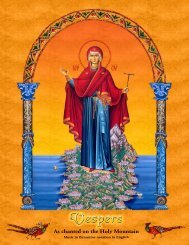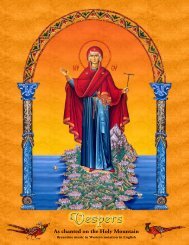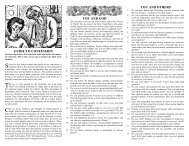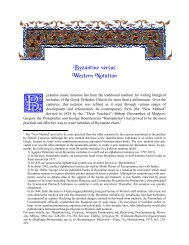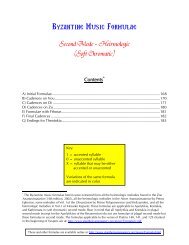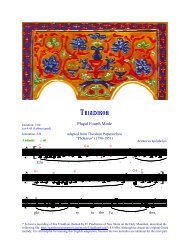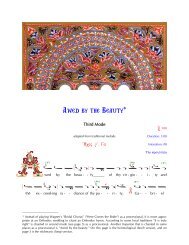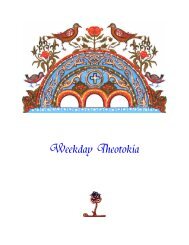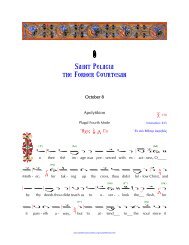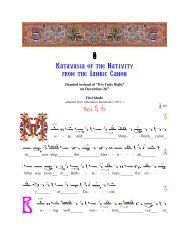Reading Psalmodia (PDF) - St. Anthony's Monastery
Reading Psalmodia (PDF) - St. Anthony's Monastery
Reading Psalmodia (PDF) - St. Anthony's Monastery
Create successful ePaper yourself
Turn your PDF publications into a flip-book with our unique Google optimized e-Paper software.
14. THEORY and PRACTICE.One of the less acceptable aspects of many conventional manuals of Psaltic theory, is theeasy and oft repeated assertion that there is a difference between theory and practice.This view has at least an ancient pedigree: the theoretical manuals produced in thePalaiologan period accepted the same view. Already in the Mediaeval manuals the gapbetween theory and practice emerges since the theorists were determined to deal withinteresting mathematical aspects of musical theory that might find little image inpractice, and equally since the authors based their theorizing on older texts which bothattempted to link Byzantine music with what they knew of ancient Greek music, andtended to discuss the chant as it may have existed at an earlier period rather thananalyse contemporary practice.Byzantine chant is part of a living, developing musical and liturgical culture. Externalinfluences played a significant role in the chant's development. During the period ofOttoman rule, the great Psaltai of Constantinople found themselves in demand as courtsingers. Many Psaltai studied and performed Ottoman Perso-Arabic classical music aswell as Byzantine <strong>Psalmodia</strong>. Indeed, Peter Lampadarios, Konstantinos Protopsaltes,Zacharias Hanade and Theodoros Phokaeos were all great experts on Ottoman music aswell as significant figures in the history of modern <strong>Psalmodia</strong>.Eighteenth century theorists of <strong>Psalmodia</strong> freely accepted the identity of the Tones ofPsaltic chant and certain of the Maqams (modes) of Ottoman music. KonstantinosProtopsaltes explains the relation between Tones and Maqams with quite extraordinaryclarity and conciseness in what was published later as the Ermeneia Tis ExoterikesMousikes. His exposition makes it evident that a family of maqams corresponds to eachTone, each maqam differentiated from the other by a subtle difference in the tuning ofspecific notes, or by a different pattern of melodic progress in ascent or descent or both,and a difference in range. The <strong>Psalmodia</strong> of the Ottoman period was composed bymusicians who were frequently steeped in Ottoman court music as much as inByzantine chant, were familiar with Muslim religious music, and often acquainted withboth the notation and the practice of Western European music. It should not, then, be asurprise that the Psaltic compositions we have inherited bear the marks of both Ottomanand Western influences: the great Psaltai who composed or arranged the chant wereworking within a living and confident tradition that was open to adaptation, and theywere ready to take into Psaltic practice elements that enhanced and beautified it, ratherthan attempting to maintain absolute purity of tradition.For theorists, the flexibility and adaptability of the Psaltic tradition poses a problem. Thebooks produced by their predecessors describe an earlier state of <strong>Psalmodia</strong> that can besignificantly different from contemporary practice. There is, moreover, a considerableproblem for theorists in finding the right balance between prescriptive and descriptiveapproaches. It is, for example, quite clear that modern Psaltai generally use a scale forpieces in Tone IV on Vu which uses different notes from the scale they use to sing piecesin Tone VIII. Now, how is the theorist to cope with this? Is the practise of singing ToneIV on Vu in a distinctly non-diatonic mode simply a corruption of the diatonic system tobe ignored by the theorist, or is the theorist to measure the intervals actually used whenTone IV is sung in this non-diatonic mode, and to present these as the tuning of Tone IV



